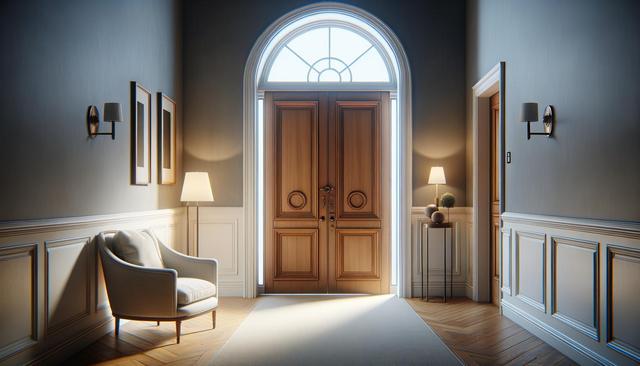Choosing the Right Entry Door Material
When exploring front door options, one of the most important decisions is selecting the right material. The material not only influences the appearance but also the durability, maintenance needs, and energy efficiency of your entry door. Common choices include steel, fiberglass, and wood, each offering distinct advantages.
Steel doors are recognized for their strength and relatively low cost. They provide a solid barrier against forced entry and require minimal upkeep. Fiberglass doors, on the other hand, are resistant to wear and weather, making them suitable for a wide range of climates. They can also mimic the look of wood grain, offering aesthetic flexibility. Wood doors bring natural beauty and warmth but may require more maintenance to prevent warping or damage from moisture.
Consider the following factors when choosing a material:
- Climate and exposure to the elements
- Your home’s architectural style
- Level of maintenance you’re willing to commit to
- Desired security features
Understanding these variables will help you select an entry door material that aligns with both your practical needs and design preferences.
Enhancing Security with Modern Entry Doors
Security is a key feature of any entry door, and modern advancements have made it easier than ever to protect your home without sacrificing style. A durable entry door should include a solid core, secure locking mechanisms, and reinforced frames. Many doors today also integrate technology for an additional layer of safety.
Look for doors with multi-point locking systems, which secure the door at several points along the frame. Reinforced strike plates and deadbolts with anti-pick features can also enhance intrusion resistance. Some entry doors are compatible with smart locks, allowing homeowners to monitor and control access remotely.
Additional security enhancements may include:
- Impact-resistant glass inserts
- Steel reinforcement within the door slab
- Motion-sensor lighting around the entryway
By considering these features, you can ensure your entry door serves as a strong first line of defense for your home.
Energy Efficiency and Insulation Benefits
Beyond security and style, energy efficiency is another critical factor when selecting an entry door. A well-insulated door can significantly reduce energy loss, leading to lower heating and cooling costs throughout the year. Look for doors that are ENERGY STAR-rated or feature insulated cores and weatherstripping.
Fiberglass and steel doors with polyurethane foam insulation offer some of the highest levels of thermal performance. Proper installation is equally important—gaps or poor seals can negate the benefits of an energy-efficient door. Weatherstripping around the frame and a tight-fitting threshold help to block drafts and maintain indoor temperatures.
Energy-efficient entry doors can:
- Improve indoor comfort year-round
- Reduce utility bills
- Minimize outside noise
- Increase the overall value of your home
Investing in an efficient entry door is not only a smart environmental choice but also a cost-effective one for long-term savings.
Design and Style Considerations
Style plays a major role in the appeal of an entry door. It’s often the first detail visitors notice and can make a lasting impression. From traditional panel designs to sleek, modern aesthetics, the range of options allows you to tailor your door to complement your home’s exterior.
Popular design elements include decorative glass inserts, sidelights, transoms, and custom hardware finishes. These details can elevate the appearance of your entry while still maintaining functionality. Color is another powerful design tool—bold hues can make a statement, while natural wood tones offer timeless charm.
When selecting a style, consider:
- Your home’s architectural design
- The desired balance between privacy and natural light
- Durability of decorative elements in your climate
Combining thoughtful design with durable materials ensures your entry door enhances curb appeal while standing up to daily use.
Installation and Maintenance Tips
Proper installation is crucial to maximizing the benefits of your new entry door. Even the highest-quality door can underperform if it’s not correctly installed. It’s recommended to work with a professional installer who understands how to align the door, seal it properly, and ensure it operates smoothly.
After installation, regular maintenance will prolong the life of your door. Maintenance routines vary by material—for example, wood doors may require periodic staining or sealing, while fiberglass and steel doors typically need only occasional cleaning with mild soap and water. Check hinges, locks, and weatherstripping periodically to ensure everything remains secure and functional.
Helpful maintenance tips include:
- Inspecting the door for signs of wear or damage each season
- Lubricating hinges and locks as needed
- Touching up paint or finish to prevent moisture intrusion
- Cleaning glass inserts to maintain visibility and appearance
With proper care, your entry door will continue to perform efficiently and look great for years to come.
Conclusion: Making the Right Entry Door Investment
Upgrading your entry door is more than just a cosmetic improvement—it’s an opportunity to enhance your home’s security, energy efficiency, and overall value. By carefully considering the material, security features, insulation, and design, you can choose an option that meets your needs and complements your home’s style. Whether you are building a new home or renovating an existing one, investing in a quality entry door is a practical and worthwhile decision. With thoughtful selection and proper maintenance, your entryway can remain a strong, stylish, and efficient feature of your home for many years.




Leave a Reply